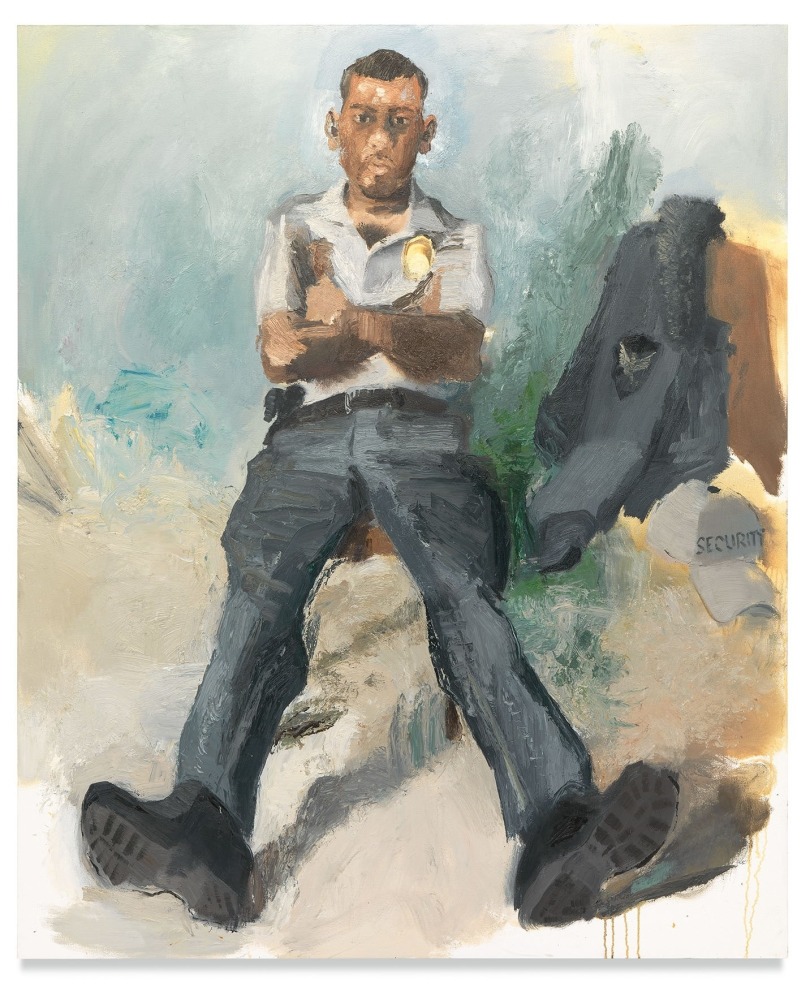John Sonsini | The Brooklyn Rail
Review by Dan Cameron

There have always been multiple entry points for viewers to come to terms with John Sonsini’s bravura portraits of single or multiple male subjects, most of whom are Mexican day laborers, and “the age of Trump” has unexpectedly provided us with yet another. We as a people have never in living memory been forced to listen to the occupant of the White House vilify Hispanic migrants and asylum seekers with the excessive slander and bitterness as its current occupant, and for millions of Americans, such rhetorical excess has prompted its own collective soul-searching. One of the reasons such hate-mongering can gain traction is because far too many of us have tended to look on such migrants as a perpetual underclass, rendering them semi-invisible in their stereotypical professional roles as delivery men, farm workers, fast food staffers, custodial help, and factory labor.
Such invisibility tends to be exaggerated in a place like Los Angeles, where Sonsini lives and works, and most importantly, finds his models. With its more limited experience of pedestrian life and shared public space, Los Angeles is, if anything, even more dependent on the vast army of Spanish-surnamed service workers that make urban life move. Affirming the humanity of individual conscripts within this army has never seemed to be a cultural priority in California, although the pendulum is now swinging in that direction, with Sonsini’s paintings leading the way.
In terms of an artistic pedigree, Sonsini’s work may seem to New York eyes to hearken to the glory days of the Ash Can school and American social realism, when such painters as George Bellows and Raphael Soyer displayed life in New York unvarnished, as the bruising, dirty and exhausting ordeal that was the reality of many unsung millions of lives. But the light and interior settings in Sonsini’s paintings should be among the first details to dispel that notion, since the subjects are nearly always posed the same way: indoors, with minimal setting and personal effects, and no interaction between them at all. Nobody laughs, talks or gesticulates, or engages in any physical activity. Instead, they look straight ahead, meeting the artist’s gaze, and our own, with an untroubled indifference.
There is a local tradition for this stylized treatment of male subjects at the prime of their lives, but that lineage has little to do with social justice, except insofar as the popularization of the male physique in LA-based photography during the 1950s and early 1960s spoke to the repressed erotic urges of untold leagues of mostly closeted gay men around the US and the world, who knew intrinsically that they were attracted to men, but, lacking appropriate visual examples, were unable to stipulate how or in what way to realize this forbidden attraction. Southern California was home at that historical moment to an incessantly swelling population of healthy young men from across the heartland, many of them direct from military service or competitive sports, and nearly all compelled to try and break into the entertainment industry. To budding entrepreneur Bob Mizer, this superabundance of potential models enabled him to market beefcake erotica to a mailing list of subscribers, without even suggesting to his models that they engage in unsavory activities in front of his camera.
If this seems like a bumpy art-historical trail to follow, one need only consider what a New York photographer like Robert Mapplethorpe achieved a couple of decades later in a post-Stonewall world, through photographs that documented some of the gay S&M community’s more exotic practices, in part to poke at his upper-class patrons’ jaded composure. By comparison, Mizer’s legacy, which includes Sonsini, insists that whatever else we might project onto their subjects, these men are seen first as who they present themselves as to the world, not as anonymous bodies inconveniently attached to fetishized portions of the male anatomy.
His insistence that these are portraits of, as Sonsini calls them, “remarkable men,” helps unlock the hidden meaning beneath the flamboyance of his brushwork. The paintings appear to have been done in single, extended sessions, with the paint laid on thickly in strokes, patches, swirls, and chunks. The props, while minimal, are precise: in Sergio and Francisco, the men have found some time to pose either before or after a soccer match, while in Miguel and Christian, the bundle next to the man on the left makes him seem ready to board a one-way bus out of town. While Sonsini is careful not to exploit any aspect of the men’s appearance that might be deemed conventionally erotic, he seems to dare us to view these men as complex embodiments of something universal in the human spirit, and also something very specific about the kind of person who would travel thousands of miles overland to a strange, often hostile place, for no reason other than to send money back home to those who, through age or gender, are unable to make the trip, but for whom those remittances sometimes constitute the difference between hope and despair for an entire family. Sonsini’s men may not be hunks in the beefcake mode, but in historical terms they are unquestionably the heroes of our age.
- Dan Cameron